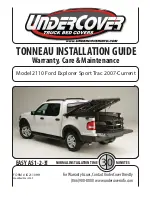
manual, and another quick reference lubrication and tire pressure chart will be
found on the left side of the dash in the engine compartment. Study these charts
carefully and be diligent in following the instructions contained therein.
The lubricants placed in your car at the time of manufacture have been
carefully tested and checked by our laboratory and NEED NOT be removed
until the recommended change period has been reached.
Engine Oil Recommendations
The selection of an engine oil and change periods depend largely upon the car
owner. IN THE SELECTION OF AN OIL, THE REPUTATION OF THE
REFINER OR MARKETER SHOULD BE TAKEN INTO CONSIDERA-
TION. HE IS RESPONSIBLE FOR THE QUALITY OF HIS PRODUCT
AND HIS REPUTATION IS THE CAR OWNER'S BEST INDICATION OF
QUALITY.
The viscosity of a lubricant is simply a measure of its body or fluidity. The
S.A.E. viscosity numbers constitute a classification of lubricants in terms of
viscosity, or fluidity, but without
reference to any other characteristics
or properties. The S.A.E. viscosity num-
bers have been adopted by practically all
oil companies and no difficulty should
be experienced in obtaining the proper
grade of lubricant to meet seasonal re-
quirements.
A quick reference table has been pre-
pared and is shown on page 12. Reference
to this table will indicate to the car
owner the proper grade of lubricant to
select for the lowest atmospheric temperature
likely to be encountered before the next oil
change.
The first oil change should be after the
car has been driven 500 miles and every
2,000 miles thereafter, unless local con-
ditions warrant more frequent changes.
When the car is operated in very
dusty territories, it is to the owner's
advantage to change oil more fre-
quently to prevent the abrasives which have found their way into the engine
from causing untold damage to bearings, pistons, rings, valves, etc.
Consistently hard driving has harmful effects on engine oil and necessitates
more frequent changing.
On the other hand, operating a car for short distances at low speeds in winter
weather does not afford an opportunity for the engine to throw off the diluents
and condensation that accumulate in the crankcase; and, if the oil is not drained
frequently, it will also have harmful effects on the engine.
Although we recommend changing engine oil at 2,000-mile intervals under
normal operation, more frequent draining is often necessary, depending on the
owner's driving habits and the conditions under which the car is operated.
O W N E R' S M A N U A L 13
Figure 1
Summary of Contents for 1938 Terraplane
Page 1: ......
Page 2: ......
Page 7: ...O W N E R S M A N U A L 5...
Page 54: ...52 H U D S O N T E R R A P L A N E Figure 43...
Page 56: ...54 H U D S O N T E R R A P L A N E Figure 45...
Page 61: ...O W N E R S M A N U A L 59...
Page 64: ...62 H U D S O N T E R R A P L A N E Figure 54...
Page 66: ...64 H U D S O N T E R R A P L A N E...
Page 82: ......
















































